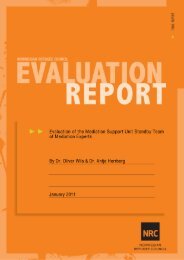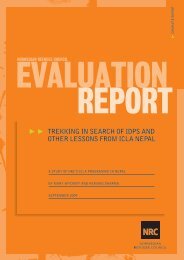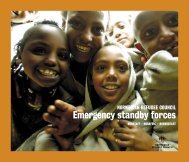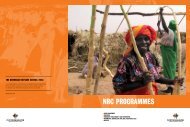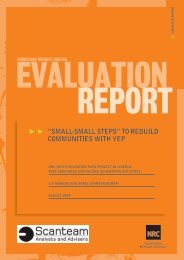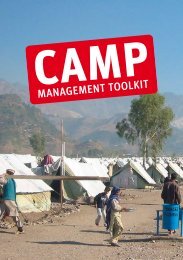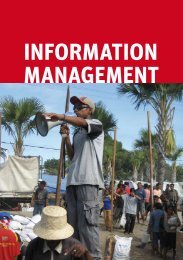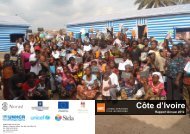evaluation of general food distribution in northern uganda: gulu ...
evaluation of general food distribution in northern uganda: gulu ...
evaluation of general food distribution in northern uganda: gulu ...
Create successful ePaper yourself
Turn your PDF publications into a flip-book with our unique Google optimized e-Paper software.
2 INTRODUCTION“…The right to adequate <strong>food</strong> is realised when every man, woman and child, alone or <strong>in</strong>community with others has physical and economic access at all times to adequate foo d ormeans for its procurement…” 3For the last 22 years, the population <strong>in</strong> the Acholi region <strong>in</strong> Northern Uganda, has beenaffected by a violent conflict between the Lord’s Resistance Army (LRA) and the Government<strong>of</strong> Uganda (GoU). In 1995-1996, the GoU decreed that all residents <strong>of</strong> areas affected by theconflict had to move <strong>in</strong>to “protected villages”. These were de facto camps with limited spaceand extremely poor liv<strong>in</strong>g conditions, creat<strong>in</strong>g an unbearable humanitarian situation forthousands <strong>of</strong> people, which <strong>in</strong> time triggered a humanitarian response. In 1997, the UNWorld Food Programme (WFP) with the Norwegian Refugee Council (NRC) as itscooperat<strong>in</strong>g partner started distribut<strong>in</strong>g <strong>food</strong> to the affected population <strong>in</strong> Gulu 4 and Kitgumdistricts. At that time there was an average <strong>of</strong> 450,000 Internally Displaced People (IDPs).The number <strong>of</strong> people today receiv<strong>in</strong>g monthly <strong>food</strong> assistance amounts to 755,000 IDPs 5 -located <strong>in</strong> the camps as well as <strong>in</strong> transit sites. In 2007 NRC distributed <strong>food</strong> to 458,000 IDPs<strong>in</strong> 65 camps and 27 transit sites <strong>in</strong> Gulu and Amuru districts, and 297,000 IDPs <strong>in</strong> 26 campsand 13 transit sites <strong>in</strong> Kitgum district. 6The objectives <strong>of</strong> the General Food Distribution Project have been to:1. To contribute to household <strong>food</strong> security and ma<strong>in</strong>ta<strong>in</strong> the m<strong>in</strong>imum nutritional anddietary standard by provid<strong>in</strong>g <strong>food</strong> assistance to people affected by displacement <strong>in</strong>camps <strong>in</strong> Gulu, Amuru and Kitgum districts.2. To protect lives by provid<strong>in</strong>g humanitarian <strong>food</strong> assistance to IDPs to meet the assessedaverage net <strong>food</strong> gap.3. To safeguard the fundamental right to <strong>food</strong> for targeted IDPs with special emphasis onwomen and children, EVIs, and the long-term effect <strong>of</strong> <strong>in</strong>sufficient access to <strong>food</strong>.After distribut<strong>in</strong>g <strong>food</strong> to IDPs for 10 years NRC decided <strong>in</strong> 2008 to conduct an <strong>evaluation</strong> <strong>of</strong>the GFD project. The purpose be<strong>in</strong>g to obta<strong>in</strong> a systematic and objective assessment <strong>of</strong> theachievements and performance <strong>of</strong> the GFD project viz the realisation <strong>of</strong> the three objective,and subsequently also to identify lessons learned which can <strong>in</strong>form recommendations forfuture project direction. To narrow down the scope and <strong>in</strong>crease relevance for future NRCprogramm<strong>in</strong>g, the <strong>evaluation</strong> period was def<strong>in</strong>ed from 2005 to 2008.2.1 Objectives & Methodology <strong>of</strong> the EvaluationIn order to assess the performance and achievements <strong>of</strong> the GFD project the follow<strong>in</strong>gOECD DAC <strong>evaluation</strong> criteria has been used: Relevance/Appropriateness; ProjectEfficiency and Coverage, Project Effectiveness, Coord<strong>in</strong>ation, Impact andL<strong>in</strong>kages/Connectedness.The GFD <strong>evaluation</strong> methodology comprised three phases: i) an <strong>in</strong>ception/desk phase tomake necessary logistical arrangements, review relevant documents and develop an<strong>evaluation</strong> tool/question guide; ii) a field phase to collect qualitative data throughobservations and <strong>in</strong>terviews/consultations with stakeholders; and (iii) a synthesis phasebr<strong>in</strong>g<strong>in</strong>g together the results <strong>of</strong> the field and desk phases.3The UN charter on Economic, Social and Cultural Rights4Gulu was divided <strong>in</strong> two adm<strong>in</strong>istrative districts <strong>in</strong> 2007, Gulu and Amuru5 The NRC Food <strong>distribution</strong> program as cooperat<strong>in</strong>g partner to WFP covers the districts <strong>of</strong> Gulu, Amuru and Kitgum. Paderdistrict is covered by World Vision.6 The follow<strong>in</strong>g part is summarised from NRC Evaluation TOR8





